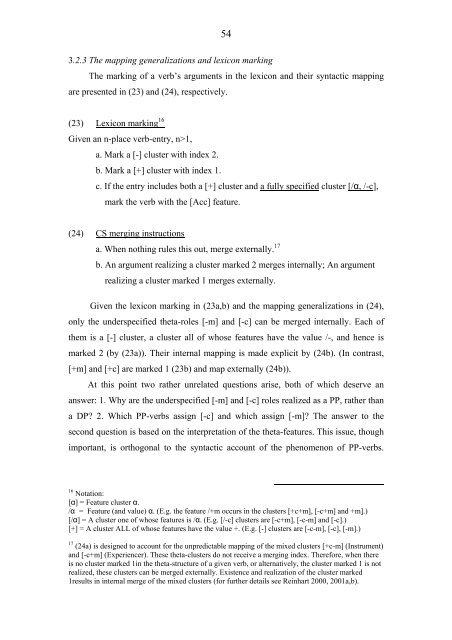The Category P Features, Projections, Interpretation
The Category P Features, Projections, Interpretation
The Category P Features, Projections, Interpretation
You also want an ePaper? Increase the reach of your titles
YUMPU automatically turns print PDFs into web optimized ePapers that Google loves.
54<br />
3.2.3 <strong>The</strong> mapping generalizations and lexicon marking<br />
<strong>The</strong> marking of a verb’s arguments in the lexicon and their syntactic mapping<br />
are presented in (23) and (24), respectively.<br />
(23) Lexicon marking 16<br />
Given an n-place verb-entry, n>1,<br />
a. Mark a [-] cluster with index 2.<br />
b. Mark a [+] cluster with index 1.<br />
c. If the entry includes both a [+] cluster and a fully specified cluster [/α, /-c],<br />
mark the verb with the [Acc] feature.<br />
(24) CS merging instructions<br />
a. When nothing rules this out, merge externally. 17<br />
b. An argument realizing a cluster marked 2 merges internally; An argument<br />
realizing a cluster marked 1 merges externally.<br />
Given the lexicon marking in (23a,b) and the mapping generalizations in (24),<br />
only the underspecified theta-roles [-m] and [-c] can be merged internally. Each of<br />
them is a [-] cluster, a cluster all of whose features have the value /-, and hence is<br />
marked 2 (by (23a)). <strong>The</strong>ir internal mapping is made explicit by (24b). (In contrast,<br />
[+m] and [+c] are marked 1 (23b) and map externally (24b)).<br />
At this point two rather unrelated questions arise, both of which deserve an<br />
answer: 1. Why are the underspecified [-m] and [-c] roles realized as a PP, rather than<br />
a DP? 2. Which PP-verbs assign [-c] and which assign [-m]? <strong>The</strong> answer to the<br />
second question is based on the interpretation of the theta-features. This issue, though<br />
important, is orthogonal to the syntactic account of the phenomenon of PP-verbs.<br />
16 Notation:<br />
[α] = Feature cluster α.<br />
/α = Feature (and value) α. (E.g. the feature /+m occurs in the clusters [+c+m], [-c+m] and +m].)<br />
[/α] = A cluster one of whose features is /α. (E.g. [/-c] clusters are [-c+m], [-c-m] and [-c].)<br />
[+] = A cluster ALL of whose features have the value +. (E.g. [-] clusters are [-c-m], [-c], [-m].)<br />
17 (24a) is designed to account for the unpredictable mapping of the mixed clusters [+c-m] (Instrument)<br />
and [-c+m] (Experiencer). <strong>The</strong>se theta-clusters do not receive a merging index. <strong>The</strong>refore, when there<br />
is no cluster marked 1in the theta-structure of a given verb, or alternatively, the cluster marked 1 is not<br />
realized, these clusters can be merged externally. Existence and realization of the cluster marked<br />
1results in internal merge of the mixed clusters (for further details see Reinhart 2000, 2001a,b).
















